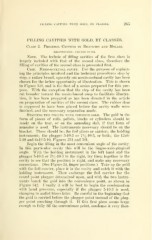Page 557 - My FlipBook
P. 557
FILUN(! CAVITIES WITH (iOI.D, BY CLASSES. 265
FILLING CAVITIES WITH GOLD, BY CLASSES.
Class 2. Proximal Cavities in Bicuspids and Molars.
ILLUSTRATIONS: FIGURES 338-364.
Note. The technic of filling cavities of the first class is
largely included with that of the second class, therefore the
filling of cavities of the second class is presented first.
Case. Mesio-occlxisal cavity. For the purpose of explain-
ing the ])rinciples involved and the technical procedures step by
step, a rather broad, squarely cut mesio-occlusal cavity has been
chosen for the better opportunity of illustration. This is shown
in Figure 340, and is the first of a series prepared for this pur-
pose. With the exception that the step of the cavity has been
cut broader toward the mesio-buccal cusp to facilitate illustra-
tion, it has been prepared as has been directed in the article
on preparation of cavities of the second class. The rubber dam
is supposed to have been placed before the cavity walls were
finished, and the necessary separation made.
Starting the filling with cohesive gold. The gold in the
form of pieces of rolls, pellets, blocks or cylinders should be
ready on the tray, or on the annealing slab, if that form of
annealer is used. The instruments necessary should be on the
bracket. These should be : the foil pliers or carrier; the holding
instrument; the plugger 5-10-3 or 7V)-10-3, or both; the 12x6-
5-10 and 6x12-5-10, Figures 324 and 341.
Begin the filling in the most convenient angle of the cavity.
In this particular cavity this will be the linguo-axio-gingival
angle. With the holding instrument in the left hand and the
plugger 5-10-3 or 7Vi.-10-3 in the right, try them together in the
cavity to see that the position is right, and make any necessary
corrections. (See Figure 51, finger positions.) Take up the gold
with the foil carrier, place it in the cavity and catch it with the
holding instrument. Then exchange the foil carrier for the
round point plugger determined upon, and with the two instru-
ments bunch the gold into the convenience point, as shown in
Figure 342. Usually it will be best to begin the condensation
with hand pressure, especially if the plugger 5-10-3 is used,
changing to mallet blows later. Be careful in the beginning that
the gold is carried before the plugger point instead of the plug-
ger point punching through it. If this first piece seems large
enough to fully fill the convenience point, condense it very thor-


